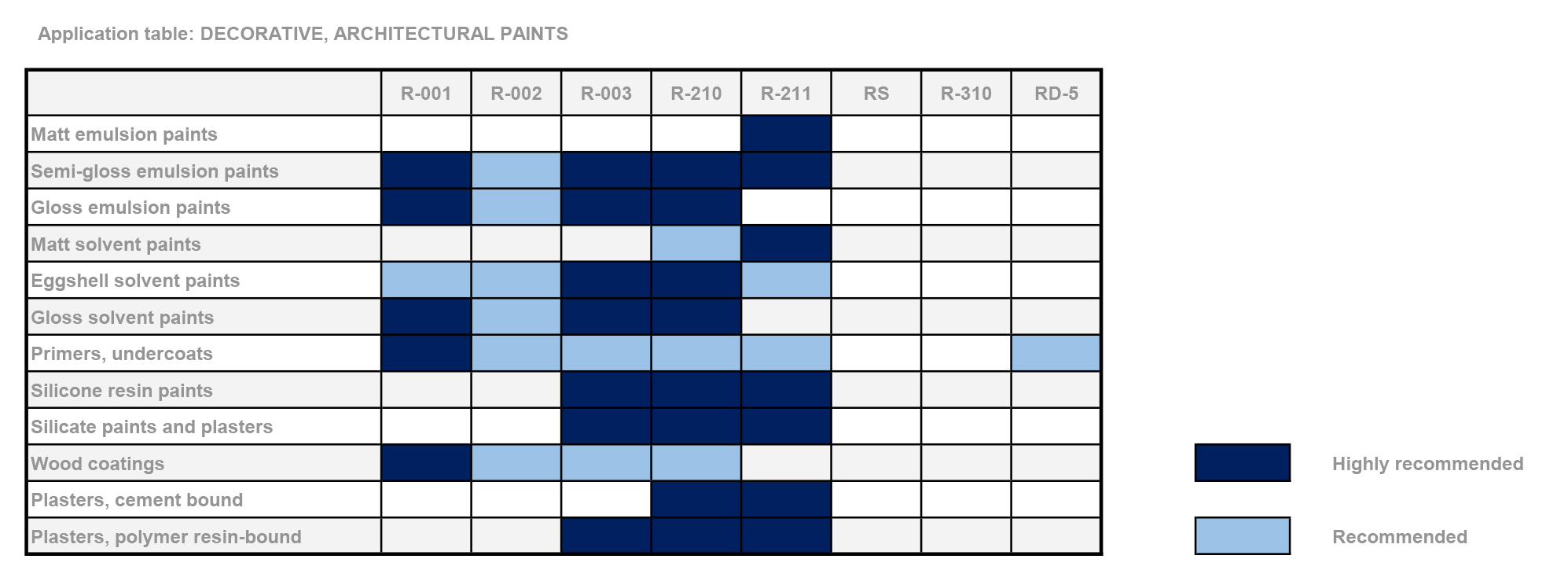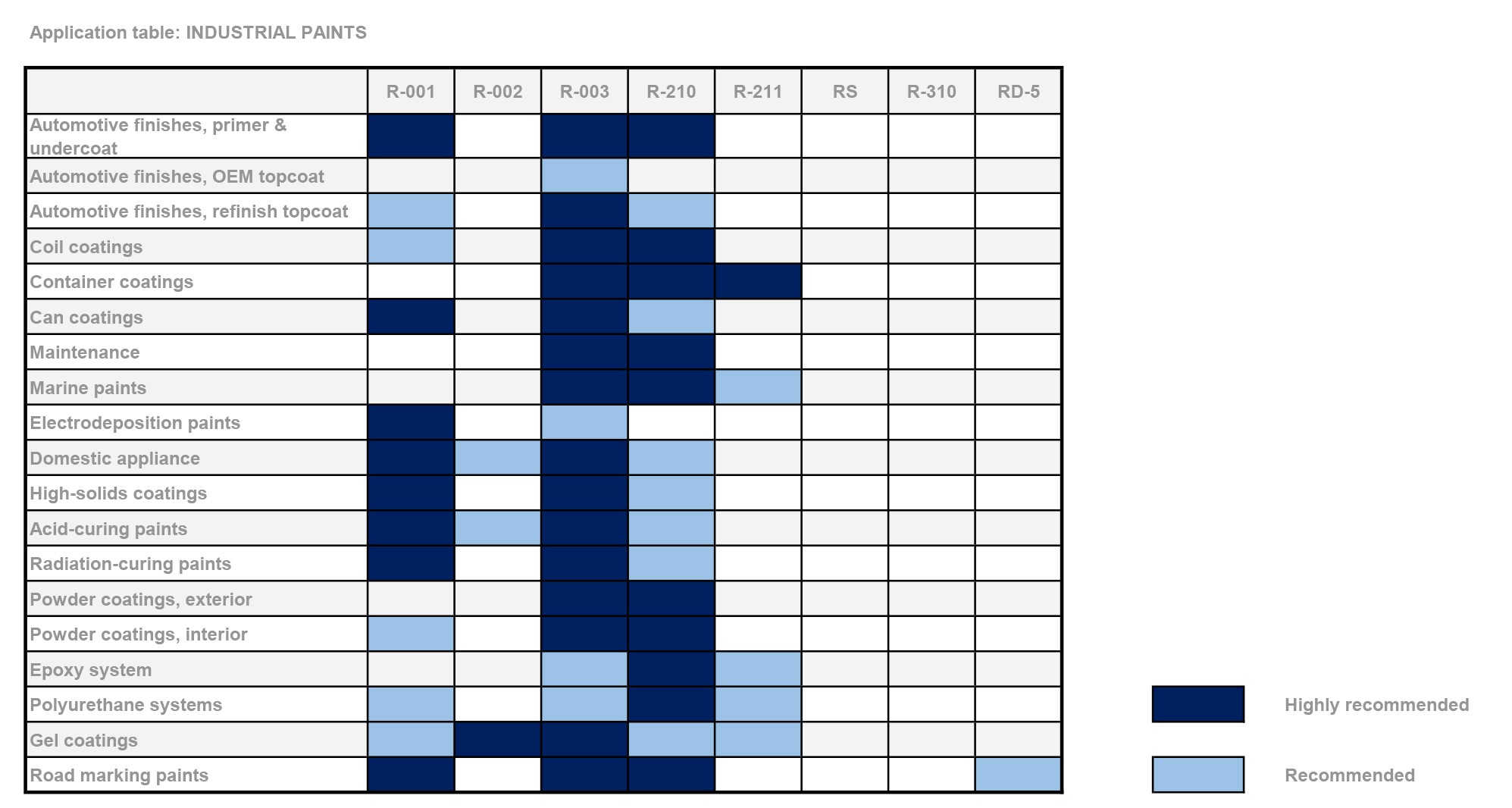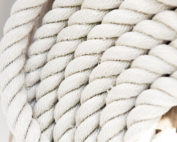The industry of coatings consumes more than half of the production of titanium dioxide pigments used mainly for the purpose of obtaining of adequate colour and non-transparency of coatings. The presence of pigment in a coating increases its durability, and – thanks to ensuring high hiding power to base – it allows for reducing of its thickness, and thus improvement of its usable properties.
Pigments used in the Paints & Coatings Industry:
Due to the multitude of products in the paint industry, broad range of brands (anatase and rutile) and sorts of titanium dioxide pigments is used (from non-treated through surface treated, up to specially treated, and meeting the most sophisticated requirements). Anatase pigments (less durable by their nature) are used in cheap dispersion paints, in self-cleaning paints, in road marking paints. Application of rutile pigments is much broader and in practice covers all paint types.
Decorative, architectonic paints
This group is characterised by broad range of requirements concerning appearance, durability and application. Therefore almost all brands of titanium dioxide are used within this group, commencing from low-resistance anatase brands up to extremely resistant surface treated rutile brands. Within this product group high hiding power, adequate whiteness and high lightening power are usually required from titanium dioxide. Resistance of titanium dioxide to the light, or – more comprehensively – to the atmospheric conditions – is of less importance than in case of industrial paints and is taken into consideration only in justified cases. However, the aspect of cost is not to be neglected – sometimes it becomes of decisive significance.
In decorative and architectonic paints rutile brands of universal character are used most often, such as TYTANPOL® R-001, R-003 and R-210. They are used on a mass scale for emulsion and solvent paints, coatings for timber or primers. In most cases, these brands ensure adequate appearance and sufficient durability of coating.
Other brands of titanium dioxide are designed for application characterised by certain specificity. And so, anatase brands are used for very cheap, low quality dispersion paints and for self-cleaning paints (use of anatase susceptibility to chalking). Silica-treated brands are eagerly used for matt dispersion paints, silicate paints, mineral plasters, and generally mineral coatings exposed to action of atmospheric conditions. Brands treated with aluminium oxide and sometimes additionally with silicon dioxide are – as a matter of fact – of broad application but are most often used to paints with gloss or semi-gloss.

Industrial paints
The group of industrial paints is also characterised by significant range of requirements concerning appearance, resistance and application. However, mainly high quality rutile brands of titanium dioxide are used within this group, at best specially coated on surface with metal oxides such as dense silica coat (TYTANPOL®R-210) or zirconium dioxide (TYTANPOL® R-003) that – while not reducing gloss of coating – significantly increase its resistance to harmful atmospheric conditions, thus extending its durability.
Within this group of products, pigment’s resistance to atmospheric conditions is many a time of greater significance than in case of decorative paints, which does not change the fact that ensuring of high hiding power, adequate whiteness and high lightening power are required from titanium dioxide at the same time.
Slightly lower resistance requirements are put towards pigments for primers and intermediate coatings – in such cases TYTANPOL® R-001 brand is recommended. Anatase brands may be used only in specific applications, e.g. in road marking paints where effects of intentional abrasion and self-cleaning of surface are used.
The most important applications of industrial paints include: automotive coatings (both new and subject to renovation), ship coatings, coatings for household appliances (refrigerators, washing machines, cookers), coatings for all types of industrial machines and structures (mainly made of metal) and road marking paints (solvent, soluble in water and thermoplastic ones).
Despite the fact that solvent paints still play a predominant role among the industrial paints, paints more environmentally friendly become more and more significant in the recent years (with significantly reduced emission of harmful volatile organic compounds): water-soluble paints, solvent paints of “high-solids” type, powder coatings and coatings cured with UV radiation or electron beam.
Taking into account a broad range of used binders, the question of pigment’s compatibility with used recipe becomes very important. For this purpose, the most often assessed are: easiness of wettability, dispersibility and grinding of pigment, stability of produced paint (susceptibility to change of viscosity, flocculation or sedimentation) and usable virtues of obtained coating (colour, gloss, adhesion to substrate, durability).

Printing inks
Titanium dioxide pigments are used in printing inks in order to give non-transparency and brightness to a coating. Selection of an appropriate pigment brand to the ink type is very important as pigment influences both ink’s rheology and gloss, colour, hiding power, susceptibility to sedimentation, abrasive properties, etc. Due to low thickness of the majority of printing coatings, titanium dioxide pigments must be characterised by narrow particle size distribution and be free of agglomerates. In applications where hiding power is a critical
parameter and the coating’s gloss is less important also highly treated brands are used. Due to high abrasion of titanium dioxide, in certain ink types, e.g. in gravure inks, pigments produced with sulphate method are used, often in anatase brand.
The greatest use of titanium dioxide is observed in flexographic and gravure inks.

KNOWLEDGE BASE
TITANIUM DIOXIDE – application
Titanium dioxide, known as titanium white, is the most important and most widespread inorganic pigment. It is used in a wide range of products we use every day, giving them appropriate apperance: the color, opacity [...]
Where to find TiO2 in daily life?
Titanium dioxide, also known as TiO2, is one of the most common pigments and is used as a basis for all colours, to give the brightness to paints, printing inks, paper, plastic products, foods, cosmetics, [...]



